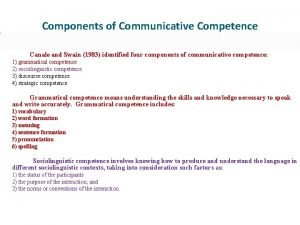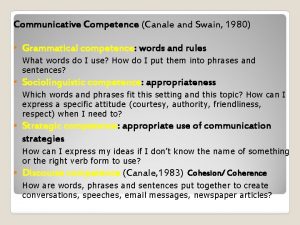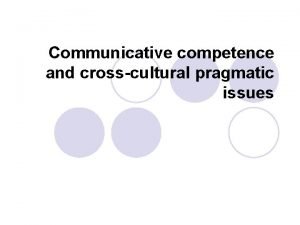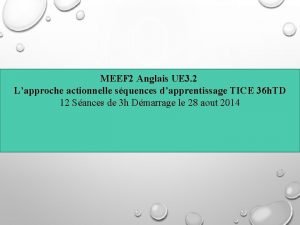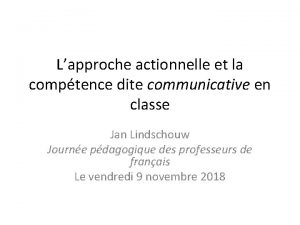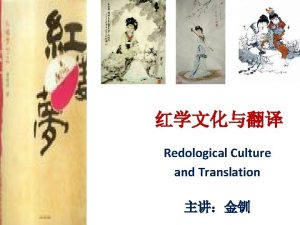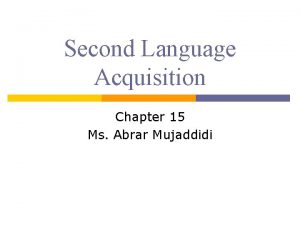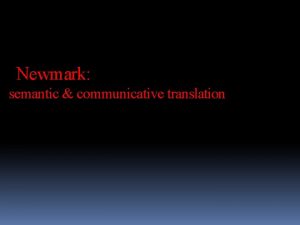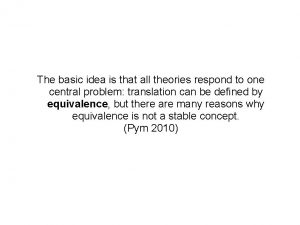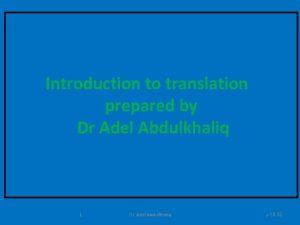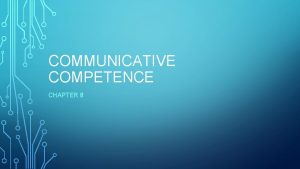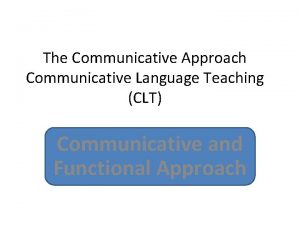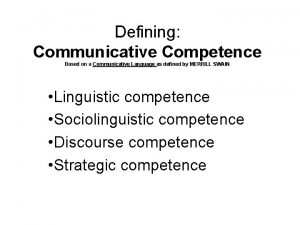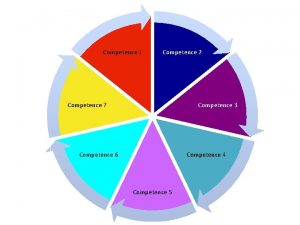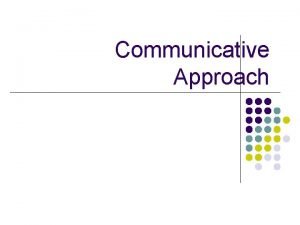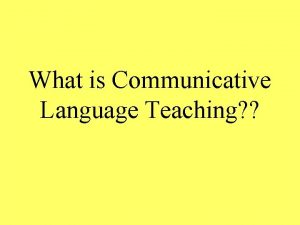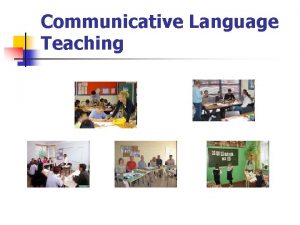Translation and Communicative Competence in Foreign Language Education













- Slides: 13

Translation and Communicative Competence in Foreign Language Education Xenia Liashuk, Ph. D. (xenia. liashuk@truni. sk) Department of English Language and Literature, Faculty of Education, Trnava University in Trnava (Slovakia)

Introduction • Malmkjær (1998): Translation as a “fifth skill” skill embracing the other four linguistic skills (reading, writing, listening and speaking) and involving simultaneous practice in all or some of them. • Cook (2010): Translation is a natural and effective means of language learning, which develops a skill in its own right, matches learners’ needs and preferences, preferences and protects their linguistic and cultural identity

Overcoming GTM limitations Grammar-Translation Method Limitations Pedagogical Translation Improvements Primary focus on grammatical structures Targeting reading comprehension and written production together with grammatical accuracy and vocabulary acquisition L 1 to L 2 direction of translation Translation both from and into L 2, including two-way and back translation Tendency to exclude listening and speaking activities Potential to generate learner-initiated allclass discussion in L 2 (e. g. Källkvist, 2013) Illusion of one-to-one correspondence between L 1 and L 2 Focus on raising awareness of contrasting features of L 1 and L 2 (e. g. Scheffler, 2013) Artificial textual input in the form of Varying textual input in terms of size free-standing phrases detached (words, sentences, passages) and style from the context of use (factual or literary texts)

Translation as a Holistic Language Activity in the Constructivist Educational Paradigm • Importance of correct pragmatic interpretation of ST contextual features and their adequate transmission in TT in view of skopos (e. g. idiolects, sociolects and dialects in Pavan, 2013) • Challenging nature of translation activity, directly related to problem-solving and demanding higher cognitive skills → motivating for learners (e. g. Pavan, 2013) • Applicable in real-world settings outside the classroom • Involvement of peers and teachers into the completion of translation activity and/or discussion it entails

Translation Proper Function: instrumental Function: informative Object: learners’ level of language proficiency Object: source text Addressee: instructor Addressee: target language reader Focus on process Focus on product Based on Klaudy (2003) in Vermes (2010) Pedagogical Translation

Translation in Educational Context Translation Proper Translation Training* (Pedagogical Translation in the broad sense) Pedagogical Translation in the narrow sense** * Simulated translation in Vermes (2010) ** School translation in Gile (1995) and Vermes (2010), the act of translating activity in Machida (2011)

Pedagogical Translation Narrow and CEFR • Translation activities feature in methodological options for modern language learning and teaching (Section 6. 4). • The applicability of translation-based methods of teaching is conditioned by “the communicative needs of learners”, learners while the materials and methods used should “satisfy these needs” and be appropriate to learners’ characteristics (p. 142).

CEFR Translation-Based Methodological Suggestions → Research Cases • Systematic learner translation into L 1 can supplement the exposure to spoken and written texts in L 2, with reading comprehension “monitored and ensured by L 2 question and answer, multiple choice, picture matching, etc. ” (Section 6. 4. 3. 1, p. 145) → Lee (2013) • Translation as one of the forms of textual production (Section 6. 4. 3. 3, p. 146) → Lee (2013) • Translation as a means of developing vocabulary through the use of monolingual and bilingual dictionaries → Fageeh, Mekheimer (2011) • Vocabulary acquisition through familiarization with translation equivalents → Liu (2013) • Translation of example sentences from L 1 to L 2 as a formal exercise targeted at grammatical competence → Scheffler (2013)

Translation Training and CEFR • Translation or interpretation is a mediating language activity, together with paraphrasing, summarizing and recording (Section 2. 1. 3. , p. 14) • To translate learners need to acquire mediation strategies which encompass the skills of making efficient use of finite resources and skills of establishing equivalent meanings • Translation involves additional cognitive skills of previewing, noting possibilities, bridging gaps, checking congruence and consistency of usage, and refining (Section 4. 4. 4. 3, p. 87 -88)

Elements of Translation Training in Foreign Language Teaching • Familiarizing beginner students with the specifics of the translation strategies of transliteration, calque and literary translation before English (L 2) to Russian (L 2) back translation in Kaloh Vid (2017) • Familiarizing non-linguistic major students with translation strategies of equation, substitution, divergence, convergence, amplification, reduction, diffusion, condensation, and reordering before English (L 2) to Farsi (L 1) translation in Davaribina, Asl (2017) • Familiarizing advanced students with rules of transferring sociolinguistic (regional variations, foreign accents), stylistic (pejoratives), pragmatic (speaker’s idiosyncrasies), intertextual (quotations, allusion, connotations and hints) features and culture-specific elements of ST before English (L 2) to Italian (L 1) subtitling and dubbing in Pavan (2013)

List of Abbreviations • L 1 – learners’ native language generally understood as the first language they have ever acquired; in classroom settings the language which is not the object of instruction • L 2 – a second/foreign language being acquired by learners which is not part of learners’ linguistics identity; in classroom settings – the language which is the object of instruction • GTM – grammar-translation method • ST – source text – the input text for the performance of translation activity • TT – target text – the output textual product of translation activity • CEFR – Common European Framework of Reference for Languages

Bibliography • • • • Common European Framework of Reference for Languages: Learning, Teaching, Assessment. Council of Europe, 2011. Available online at : https: //rm. coe. int/16802 fc 1 bf. COOK, G. : Translation in language teaching: An argument for reassessment. Oxford: Oxford University Press, 2010. DAVARIBINA, M, ASL, S. E. : “Do Different Instruction Modalities Matter? Exploring the Influence of Concept Mapping and Translation Strategies Instruction on the Reading Comprehension Ability of Adult EFL Learners”. Journal of Language Teaching and Research, 2017, Vol. 8, No. 4, pp. 761 -767. FAGEEH, A. I. , MEKHEIMER, M. A. A. : “EFL Learners' Vocabulary Acquisition in Translational Writing”. Journal of Language Teaching and Research, 2011, Vol. 2, No. 4, pp. 918 -928. KÄLLKVIST, M. : The Engaging Nature of Translation: a Nexus Analysis of Student-Teacher Interaction. In: TSAGARI, D. , FLOROS, G. (eds. ): Translation in Language Teaching and Assessment. Cambridge Scholars Publishing, 2013, pp. 115133. KALOH VID, N. : “The Use of Back Translations in the Linguistic Class: Teaching Russian Through English”. Informatologia, 2017, Vol. 50, No. 3 -4, pp. 210 -213. KLAUDY, K. : Languages in Translation. Budapest: Scholastica, 2003. LEE, T. -J. : Incorporating translation into the language classroom and its potential impacts upon L 2 learners. In: TSAGARI, D. , FLOROS, G. (eds. ): Translation in Language Teaching and Assessment. Cambridge Scholars Publishing, 2013, pp. 322. LIU, C. : “The Effect of Different Translation Tasks on Incidental Vocabulary Acquisition”. Chinese Journal of Applied Linguistics, 2013, Vol. 36, No. 3, pp. 326 -337. MALMKJAER, K. (ed. ): Translation & language teaching: Language teaching & translation. Manchester , UK: St. Jerome Publishing, 1998. PAVAN, E. : “The Simpsons: Translation and language teaching in an EFL class“. Studies in Second Language Learning and Teaching, 2013, Vol. 3, No. 1, pp. 131 -145. SCHEFFLER, P. : “Learners’ perceptions of grammar-translation as consciousness raising”. Language Awareness, 2013, Vol. 22, Issue 3, pp. 255 -269. VERMES, A. : “Translation in Foreign Language Teaching: A Brief Overview of Pros and Cons”. Eger Journal of English Studies, 2010, Vol. X, 2010, pp. 83 -93.

The present study was carried out within KEGA 055 UKF-4/2016 research project.
 Semantic translation
Semantic translation Noun phrase example
Noun phrase example Canale and swain communicative competence
Canale and swain communicative competence Communicative competence canale and swain
Communicative competence canale and swain Our wines leave you nothing to hope for
Our wines leave you nothing to hope for La compétence communicative
La compétence communicative La compétence communicative
La compétence communicative Communicative translation
Communicative translation Here you are too foreign for home
Here you are too foreign for home Learning vs acquisition
Learning vs acquisition Difference between second language and foreign language
Difference between second language and foreign language Communicative translation example
Communicative translation example Communicative translation
Communicative translation Semantic translation
Semantic translation


